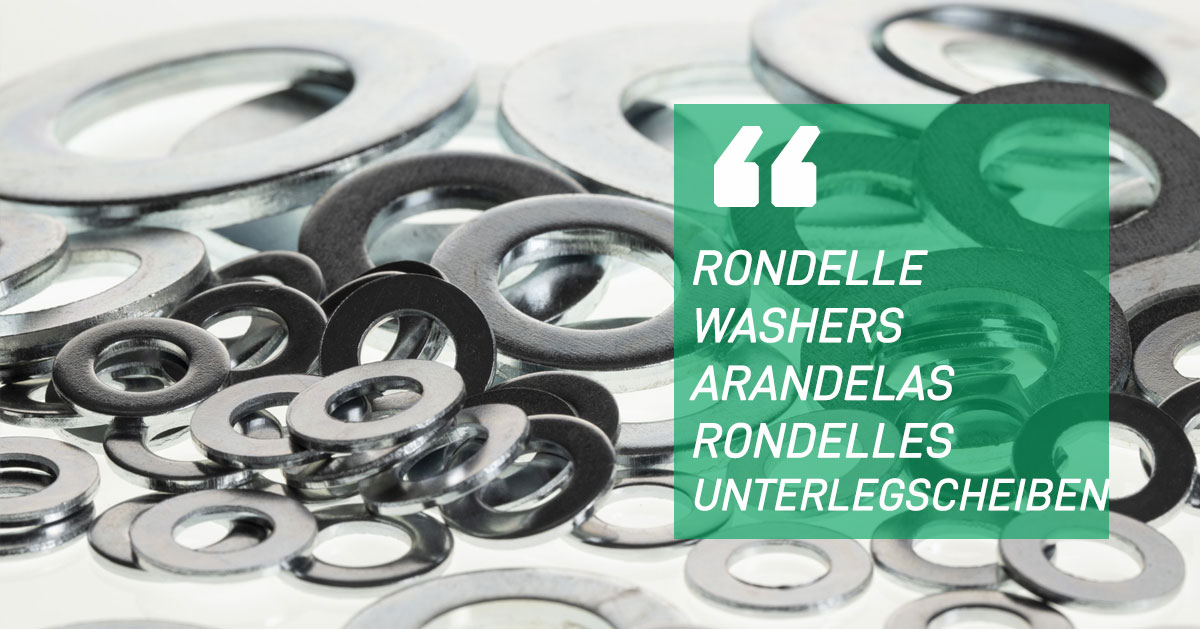
A washer for each task
Washers are multipurpose fasteners that due their versatility are largely employed in the manufacturing, assembling and various other industrial sectors along with screws, nuts and bolts.
Even though washers are manufactured in large variety of shapes and dimensions, they consist of a thin plate disc with a hole in the middle which assures the tightening of threaded fasteners.
Washers fulfil different functions on the basis of their shape, thickness and material they are manufactured with.
First of all, washers are used to distribute the load of the fasteners (nuts or bolts) evenly over a surface without damage.
Secondly, they can be employed to ensure the nut is pressed against a smooth surface while reducing the chances of loosening over time.
Furthermore, washers can also create a separation or space between fasteners, prevent corrosion (between a steel screw and an aluminum surface for example) and wear and reduce vibrations produced by a machine or equipment.
Materials
This kind of fasteners are commonly manufactured in different materials.
Along with carbon steel and stainless steel other metals are largely employed to produce washers. That includes copper, brass, aluminium, titanium, bronze, etc.
In addition to metal, some other materials such as alloy, plastic or nylon are used to produce washers for specific tasks.
Functionally speaking, washers can be classified in three main categories:
* Plain washers
* Spring washers
* Locking washers
Plain washers
Plain washers, are the most common type of washers. They are typically designed to distribute the force of a nut or bolt, while protecting the respective surface from damage. Moreover, flat washers can be used when the hole is bigger than the nut.
Common examples of plain washers include:
* Flat washers: Flat washers are a ring, often of metal, used to spread the load of a screwed fastening.
* Fender washers: An oversize flat washer with a larger outer diameter proportional to the central hole. They are able to distribute loads more widely especially on soft materials.
* Spherical washers: Consist of one radiuses surface which, when used with a mating nut, allows for several degrees of misalignment between parts.
* Countersunk washer: When secured, this type of washer creates a flush surface.
Spring washers
A second type of washers are spring washers. They are characterized by an axial flexibility which helps prevent fastening or loosening as a result of vibrations or shock.
That makes spring washers ideal for applications in machines and equipment that create strong vibrations.
Types of spring washer include:
* Belleville washers: are characterized by a slight conical shape which helps maintain the tension in assemblies where there is thermal expansion and contraction.
* Curved disc springs: similar to a Belleville, except they are only curved in one direction. Therefore, they have only four points of contact and are mainly used to support relatively light loads with a wide deflection range.
* Wave washers: Have a ‘wave’ in the axial direction which makes it suitable for use as a cushion spring or spacer. Wave washers, of comparable size, do not produce as much force as Belleville washers.
* Split washers: Have a ring that is split at one point and bent into a helical shape creating more friction and rotation resistance. Split washers allow the thread to be tightened in a right hand direction only (i.e. a clockwise direction) owing to their shape.
Locking washers
A locking washer is a special type of washer that is used to prevent fastening or loosening. This kind of washers work similarly to spring washers of which they represent a sub-type.
Types of locking washer include:
* Toothed lock washers: Toothed lock washers have serrations around their edge which can extend inward or outward to bite into the surface material and provide maximum torsional resistance. This type of washers is effective as a lock washer when used with a soft substrate, such as aluminium or plastic. They can resist to rotation more than a plain washer on hard surfaces, because the tension between washer and the surface is applied over a much smaller area (the teeth). There are four types: internal, external, combination, and countersunk
* Tab washers: Tab washers are a type of lock washer, characterized by one or more side tab and notches which can be bent into place against bolts and nuts after assembly to prevent rotation. This kind of washers are ideal to use in applications characterized by extreme heat conditions or heavy vibrations, in so far as they effectively lock a part into place. Tab washers have, progressively, replaced the use of locking pins and castle or slotted nuts.